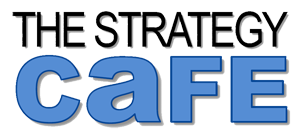The 7 Cs – Your Big Idea / Concept in more detail
It is important to create as detailed a picture or story about your intended business as you can. To help you to do this we will explore your business idea / Concept in terms of the Strategy Cafe’s CaFE Process a set of issues that we sometimes like to call “The 7 Cs”.
These overlapping issue sets cover the most important aspects of any business.
Whilst they seem like a simple set of headings you need to consider each in depth and consider how a change in one area results in a need to change in another, in that way you will build up a more integrated view of the business and will be better able to adapt and change the Business Idea, Business Model and chose the best strategies for leading and driving the business forward.
- Customers
- Competition
- Collaborators
- Costs
- Cash Flows
- Communication
- Contexts
When you consider these issues you need to do so in some detail.
1. Customers
- People? If so are they young or old? Men or Women? Where are they? What do they read? What do they Buy? How can you reach them to tell them about your business?
- Businesses? If so what do they do? What customers do they serve? Where are they based?
2. Competition
- Other companies or people who do what we do, for the kinds of people we do it for.
- Other things that solve the same problem or meet the same needs for our intended customers.
3. Collaborators
- Provide related products or services
- Sit up or down stream in the “supply chain”
- Work beside us in serving the same or similar customers but doing different things to us.
4. Costs
Your cost set will almost certainly relate to and be driven by your Business Model and any change in that model will have an effect your costs.
We do not intend to enter in to a detailed discussion from an accountancy perspective, there are plenty of sites and sources of information on that. The two main areas to think about at this stage are your:
- Start-up Costs – i.e. all the things you need to get started in business.
- Operating Costs – i.e. all the things you will need to pay for once you are up and running.
If you are interested in Costing as a topic, we have found Activity Based Costing to be the best tool to use. You can find out more through Google or Wikipedia.
5. Cash Flows
- Your Operating Costs above are your cash outflows.
- Your Income from sales (and any other sources such as grants) are cash in-flows.
As well as considering both cash infolws and outflows, you need to consider timing and the effect that different customer types have on your business. Whilst private individuals may pay you in cash promptly, Businesses are likely to want and to take Credit terms and you may find some won’t pay to time. You need to be realistic and to plan for this. It has been said that Cash is King. to some degree that is true.
6. Communication
- Internal Communication – all aspects of how you communicate with your staff and colleagues.
- External Communication – all aspects of your communication outside your business i.e. with Prospects, Customers, Suppliers etc.
7. Contexts
- The Context of your Customer i.e. what is the thing that links all your customers at the point of need / contact with your business?
- The Context of your Business i.e. what is going on within the business, what kind of business do you want / need at this stage? How well equipped are you to take on new work and new types of work?
- The Business Environment in which you operate – we can use the PESTLED acronym as a series of prompts as below.
When we talk about the Business Environment it can be useful to think about changes and developments in our chosen market or in the wider society using the following headings:
- Political – are there any changes in government at a local, regional or national level and how might they affect you / your business / your customers?
- Economic – what is the Economic climate and how might it affect you … ?
- Social – are there change in society that affect your client group?
- Technological – are there new technologies or technological developments in your industry or sector?
- Legal – are there laws, rules or regulations or pending changes in law that you need to pay regard to?
- Environmental – how does your business impact on the environment and how can you minimise that?
- Demographic – in the UK and Europe we have an ageing demographic – does that have an impact on your business? Does it create or limit your opportunities?
Write notes in your workbook or note pad on these issues, these will be key information for your Business Plan in Step 4.
Go to Step 1 Go to Step 3
© 2011 – 2014, The Strategy Cafe, all rights reserved.
